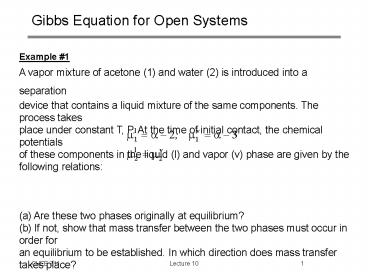Gibbs Equation for Open Systems - PowerPoint PPT Presentation
1 / 3
Title:
Gibbs Equation for Open Systems
Description:
A vapor mixture of acetone (1) and water (2) is introduced into a separation ... of your coffee when you add a teaspoon of sugar (n2=0.01 mol) to it? ... – PowerPoint PPT presentation
Number of Views:44
Avg rating:3.0/5.0
Title: Gibbs Equation for Open Systems
1
Gibbs Equation for Open Systems
Example 1 A vapor mixture of acetone (1) and
water (2) is introduced into a separation device
that contains a liquid mixture of the same
components. The process takes place under
constant T, P. At the time of initial contact,
the chemical potentials of these components in
the liquid (l) and vapor (v) phase are given by
the following relations (a) Are these two
phases originally at equilibrium? (b) If not,
show that mass transfer between the two phases
must occur in order for an equilibrium to be
established. In which direction does mass
transfer takes place?
2
Ideal Gas Mixing
Example 2 (SVNA 11.2) A vessel, divided into two
parts by a partition, contains 4 mole of
nitrogen at 75 oC and 30 bar on one side and 2.5
mole of argon gas at 130 oC and 20 bar on the
other. If the partition is removed and the gases
mix adiabatically and completely, what is the
change in entropy? Assume nitrogen an ideal gas
with Cv(5/2)R and argon an ideal gas with
Cv(3/2)R.
3
Gibbs Energy of Mixing -Ideal Solutions
Example 3 Have you ever wondered by how much you
increase the Gibbs energy of your coffee when
you add a teaspoon of sugar (n20.01 mol) to it?
The following assumptions/simplifications can be
made ? Your sugar-free coffee (n110 mol) is
just pure water ? The sugar you are adding to it
is made of pure,dehydrated glucose (G2,
pure(T,P) 1.00 kJ mol-1). ? The mixing process
is isothermal (T50 oC) and isobaric (P1 atm) ?
The mixture behaves as ideal solution

